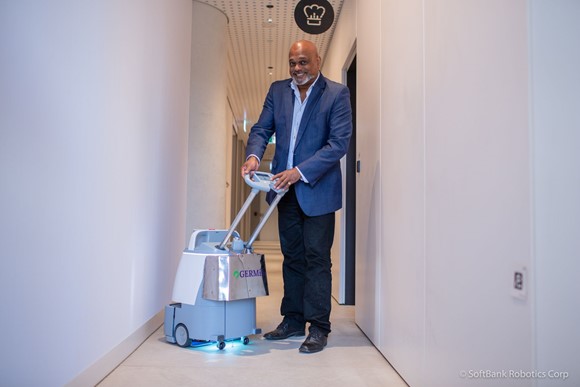How tech can ease the cleaning industry’s manpower crunch
Harold Van Haltren, CEO of pathogen mitigation company GERMii, explores the trends that will shape public cleanliness.
In Disney’s Snow White and the Seven Dwarfs, Snow White enlists forest animals to help tidy a grimy cottage. Squirrels dust off the furniture, raccoons scrub out the linens, chipmunks do the dishes. The cottage is sparkling in the blink of an eye.
Like Snow White, we’ve probably all wished for helping hands to magically clean out our spaces. This sentiment is certainly felt in service industries today, as Covid-19 triggers an unprecedented need for cleanliness.
This increased demand is likely here to stay. In response, Harold Van Haltren, CEO of Australia-based pathogen mitigation company GERMii, shares his thoughts on the latest trends governments should watch.
Robots can complement cleaning staff
As a “direct result” of the pandemic, there has been an enormous focus on cleaning and sterilising, Van Haltren remarks.
For instance, Singapore mandated that public areas from hawker centres to schools and eldercare centres need to be cleaned at a minimum frequency. The National Environment Agency (NEA) is even planning an overhaul of toilets at hawkers centres and food courts to increase public cleanliness.
In response, Singapore’s cleaning companies seem willing to push the envelope and embrace tech. Over 770 businesses applied for the NEA’s enhanced Environmental Services Productivity Solutions Grant, unlocking $15 million in subsidies for cleaning solutions.
Robots can help organisations cope with growing demand for cleanliness by taking over time-consuming, repetitive manual tasks. Cleaners can then focus on more important tasks, such as sterilising “high-touch, high-risk or difficult-to-clean areas” like elevator buttons, bathrooms, and desks.
In this way, robots “complement” workers instead of competing with them. With more time to take on new tasks, employees may be able to value-add by offering “additional services to customers”, Van Haltren says.
For instance, SoftBank Robotics’ AI-powered commercial floorcare cleaning robot, Whiz, automates vacuuming so cleaners can focus on human-centric tasks. Whiz automatically avoids obstacles and sends operators real-time data and alerts, giving managers peace of mind despite minimal monitoring.
Embracing workforce transformation
In tandem, organisations need to upskill their workforce. This includes teaching cleaning staff and managers how to operate robots, analyse robot-collected data, and project trends to optimise workflows.
Organisations can use coronavirus-related fluctuations in cleaning demand to their advantage. As the Covid-19 situation evolves and directives change, some venues may experience a temporary drop in cleaning demand due to restricted footfall.
When this happens, employers can consider sending cleaners for training and upskilling, said a Singapore government advisory. This kills two birds with one stone, with less opportunity cost incurred when staff take time off to learn. These employees return more efficient and effective, ready to fully make use of the latest cleaning technology.
SoftBank Robotics Singapore, the Asia-Pacific headquarters, has partnered with Singapore’s National Trades Union Congress LearningHub to train cleaners to properly deploy robots such as Whiz. Managers and supervisors learn to analyse cloud data visualisation and status reports to increase productivity and make more informed deployment decisions in the long run.
Effective, high-tech cleaning mediums
Even as citizens take more interest in cleanliness, Van Haltren cautions against deploying cleaning products with a heavy hand. Performatively over-cleaning — a phenomenon dubbed “hygiene theater” — can be ineffective or even dangerous.
Currently, conventional cleaning involves the “application of harsh antiviral chemicals”, Van Haltren explains. This is “concerning” from health, cost, and environmental perspectives — “no one really knows what the long-term impact of excessive chemical use will be.”
Organisations need to clean cautiously but not irrationally. Staff should be instructed not to over-use products, and disinfectants need to be screened thoroughly to avoid ingredients with adverse side effects such as respiratory irritation or disease.
Whiz is an AI vacuum cleaning robot of SoftBank Robotics, and Germii UV-C is an attachment device dedicated for the robot.
New technology offers potential fixes. GERMii’s technology transforms Ultraviolet-C (UV-C) into a concentrated beam of light that is “lethal to viruses, bacteria, and pathogens”. This disinfects surfaces without relying on chemicals — cleaning staff just need to wipe down surfaces with “soap and cloth”.
This solution can be deployed on top of Whiz. With Whiz, the UV-C light module is close enough to the floor surface to eliminate Covid-19, bacteria, and fungi “almost instantly”. This is effective even on soft floor coverings like carpets.
As more consumers emphasise the importance of cleanliness, organisations need to scale up the capacity, efficiency, and effectiveness of their services. Innovative new tools and employee upskilling may just be the fix to help them achieve these goals.


